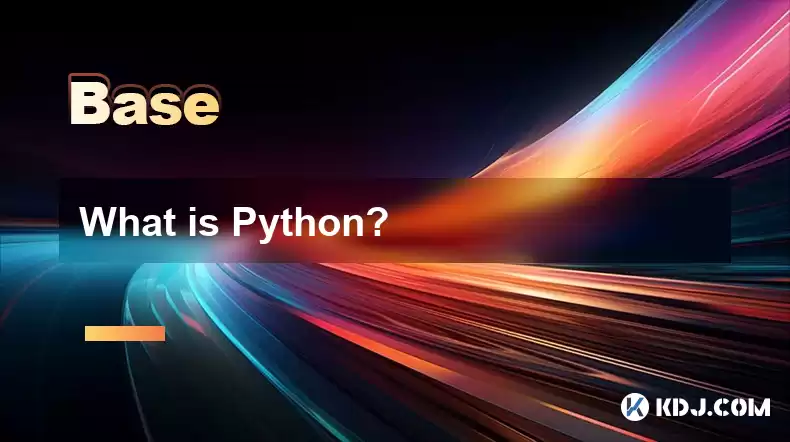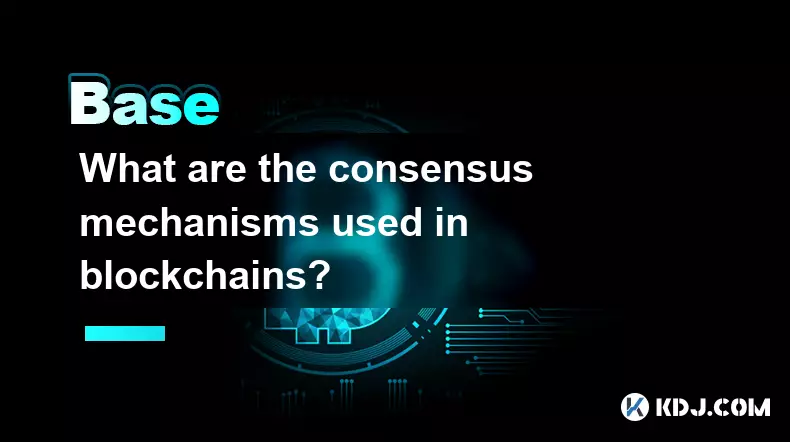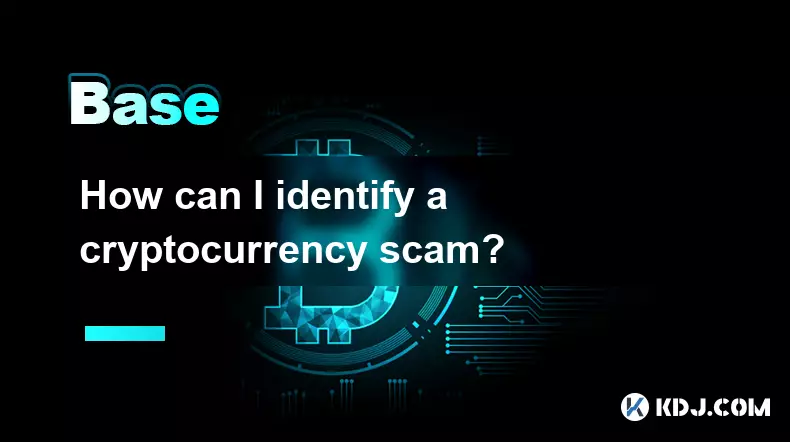-
 bitcoin
bitcoin $112371.712755 USD
-0.18% -
 ethereum
ethereum $4188.969598 USD
-0.18% -
 tether
tether $1.000202 USD
-0.05% -
 xrp
xrp $2.834903 USD
-0.51% -
 bnb
bnb $1021.658413 USD
3.04% -
 solana
solana $215.188750 USD
-1.77% -
 usd-coin
usd-coin $0.999803 USD
0.00% -
 dogecoin
dogecoin $0.239438 USD
-0.51% -
 tron
tron $0.336588 USD
-1.10% -
 cardano
cardano $0.812415 USD
-1.22% -
 hyperliquid
hyperliquid $45.019578 USD
-2.90% -
 chainlink
chainlink $21.594825 USD
-0.13% -
 avalanche
avalanche $34.271321 USD
2.56% -
 ethena-usde
ethena-usde $1.000931 USD
-0.07% -
 sui
sui $3.354033 USD
-0.29%
What is Python?
Python's simplicity and extensive libraries make it ideal for cryptocurrency tasks like trading bots, blockchain analysis, and smart contract development.
Apr 09, 2025 at 06:43 pm

Python is a versatile and widely-used programming language that has found significant application within the cryptocurrency and blockchain industries. Known for its simplicity and readability, Python is favored by developers for creating scripts, automating tasks, and developing complex applications. In the context of cryptocurrencies, Python is used for various purposes, including trading bots, blockchain analysis, and smart contract development.
Python's Role in Cryptocurrency
Python plays a crucial role in the cryptocurrency ecosystem. Its ease of use and extensive libraries make it an ideal choice for developers working on blockchain projects. For instance, Python is often used to develop trading bots that can execute trades automatically based on predefined criteria. These bots can analyze market data, make decisions, and interact with cryptocurrency exchanges through APIs. Additionally, Python is used for blockchain analysis, where developers can write scripts to parse and analyze blockchain data to gain insights into transaction patterns and network behavior.
Python Libraries for Cryptocurrency
Several Python libraries are specifically designed for cryptocurrency and blockchain development. One of the most popular is ccxt, which provides a unified API to interact with various cryptocurrency exchanges. This library allows developers to write code that can work across multiple exchanges without needing to modify the code for each exchange. Another important library is web3.py, which is used for interacting with Ethereum and other EVM-compatible blockchains. It enables developers to send transactions, deploy smart contracts, and query blockchain data.
Building a Simple Trading Bot with Python
To illustrate how Python can be used in the cryptocurrency space, let's walk through the process of building a simple trading bot. This bot will use the ccxt library to connect to a cryptocurrency exchange and execute a basic trading strategy.
- Install the ccxt library: Open your terminal and run the command
pip install ccxt. - Import the necessary modules: In your Python script, start by importing the required modules. For example,
import ccxt. - Initialize the exchange: Create an instance of the exchange you want to use. For example,
exchange = ccxt.binance({'apiKey': 'YOUR_API_KEY', 'secret': 'YOUR_SECRET_KEY'}). - Fetch market data: Use the exchange's API to fetch the latest market data. For example,
ticker = exchange.fetch_ticker('BTC/USDT'). - Implement a trading strategy: Based on the market data, implement a simple trading strategy. For example, if the current price is below a certain threshold, buy; if it's above another threshold, sell.
- Execute trades: Use the exchange's API to execute trades. For example,
order = exchange.create_market_buy_order('BTC/USDT', 0.01).
Python for Blockchain Analysis
Python is also widely used for blockchain analysis. Developers can write scripts to extract and analyze data from blockchain networks. For example, using the web3.py library, developers can connect to the Ethereum blockchain and retrieve transaction data.
- Install web3.py: Open your terminal and run the command
pip install web3. - Import the web3 module: In your Python script, import the web3 module. For example,
from web3 import Web3. - Connect to the Ethereum network: Use an Ethereum node or a service like Infura to connect to the Ethereum network. For example,
w3 = Web3(Web3.HTTPProvider('https://mainnet.infura.io/v3/YOUR_PROJECT_ID')). - Fetch transaction data: Use the web3.py API to fetch transaction data. For example,
tx = w3.eth.get_transaction('0xTRANSACTION_HASH'). - Analyze the data: Write scripts to analyze the fetched data, such as calculating transaction volumes, identifying patterns, or tracking specific addresses.
Python and Smart Contract Development
While Python is not typically used for writing smart contracts directly, it can be used in conjunction with other tools to facilitate smart contract development. For instance, Brownie is a Python-based framework for Ethereum smart contract development. It allows developers to write, test, and deploy smart contracts using Python.
- Install Brownie: Open your terminal and run the command
pip install eth-brownie. - Create a new project: Use the Brownie CLI to create a new project. For example,
brownie init. - Write a smart contract: Write your smart contract in Solidity and save it in the
contractsdirectory. - Write tests: Use Python to write tests for your smart contract. These tests can be run using the Brownie CLI.
- Deploy the contract: Use Brownie to deploy your smart contract to the Ethereum network. For example,
brownie run scripts/deploy.py --network mainnet.
Python for Data Visualization in Cryptocurrency
Python is also an excellent tool for data visualization in the cryptocurrency space. Libraries like Matplotlib and Seaborn can be used to create charts and graphs that help visualize market trends and transaction data.
- Install Matplotlib: Open your terminal and run the command
pip install matplotlib. - Import Matplotlib: In your Python script, import Matplotlib. For example,
import matplotlib.pyplot as plt. - Fetch data: Use libraries like ccxt or web3.py to fetch the data you want to visualize.
- Create a plot: Use Matplotlib to create a plot. For example,
plt.plot(data['date'], data['price']). - Customize the plot: Add labels, titles, and other customizations to make the plot more informative.
- Display the plot: Use
plt.show()to display the plot.
Frequently Asked Questions
Q: Can Python be used to develop decentralized applications (dApps)?A: Yes, Python can be used to develop the front-end and back-end components of decentralized applications. While smart contracts are typically written in languages like Solidity, Python can be used to interact with these contracts and build user interfaces.
Q: Is Python suitable for high-frequency trading in cryptocurrencies?A: Python can be used for high-frequency trading, but it may not be the most optimal choice due to its slower execution speed compared to languages like C++ or Rust. However, with the right optimizations and libraries, Python can still be effective for high-frequency trading.
Q: Are there any Python libraries specifically designed for Bitcoin?A: Yes, there are several Python libraries designed for Bitcoin, such as bitcoinlib and pycoin. These libraries provide tools for working with Bitcoin transactions, addresses, and the Bitcoin network.
Q: How can Python be used to secure cryptocurrency wallets?A: Python can be used to develop secure cryptocurrency wallets by implementing encryption and secure key management. Libraries like cryptography can be used to encrypt private keys and secure wallet data.
Disclaimer:info@kdj.com
The information provided is not trading advice. kdj.com does not assume any responsibility for any investments made based on the information provided in this article. Cryptocurrencies are highly volatile and it is highly recommended that you invest with caution after thorough research!
If you believe that the content used on this website infringes your copyright, please contact us immediately (info@kdj.com) and we will delete it promptly.
- Cardano's Eight-Figure Stablecoin Plan: Will It Spark an ADA Price Rally?
- 2025-09-25 04:25:14
- Bitcoin Core, Bitcoin Knots, and Actions Speak Louder Than Words
- 2025-09-25 04:45:14
- Bitcoin Cash, BlockchainFX, and the Hunt for 100x Crypto in 2025
- 2025-09-25 05:05:15
- Optimism Price Rebound: Whale Accumulation Signals Bullish Momentum
- 2025-09-25 04:45:14
- Ethereum's 'Google Moment': Vitalik Buterin, Base, and the Future of Growth
- 2025-09-25 05:05:15
- PI Coin, Price Prediction, and Remittix: What's the Buzz?
- 2025-09-25 04:50:01
Related knowledge

How can I earn passive income from cryptocurrency?
Sep 23,2025 at 10:18am
Staking Cryptocurrencies for Regular Returns1. Many blockchain networks operate on a proof-of-stake (PoS) consensus mechanism, allowing users to earn ...

What are the consensus mechanisms used in blockchains?
Sep 24,2025 at 10:00am
Proof of Work and Its Role in Blockchain Security1. Proof of Work (PoW) is one of the earliest consensus mechanisms, first implemented by Bitcoin. Min...

Is there a finite supply of Bitcoin?
Sep 23,2025 at 06:00am
Bitcoin's Fixed Supply Mechanism1. Bitcoin was designed with a hard cap of 21 million coins, making its supply finite and predictable. This limit is h...

How do decentralized exchanges (DEXs) work?
Sep 23,2025 at 09:54pm
Understanding the Mechanics of Decentralized Exchanges1. Decentralized exchanges operate without a central authority, allowing users to trade cryptocu...

How are cryptocurrency transactions taxed?
Sep 23,2025 at 04:36am
Taxation of Cryptocurrency TransactionsCryptocurrency transactions are subject to various tax regulations depending on jurisdiction, usage, and freque...

How can I identify a cryptocurrency scam?
Sep 24,2025 at 04:36am
Red Flags in Project Documentation1. The whitepaper lacks technical depth and avoids explaining the underlying blockchain mechanics. It often uses buz...

How can I earn passive income from cryptocurrency?
Sep 23,2025 at 10:18am
Staking Cryptocurrencies for Regular Returns1. Many blockchain networks operate on a proof-of-stake (PoS) consensus mechanism, allowing users to earn ...

What are the consensus mechanisms used in blockchains?
Sep 24,2025 at 10:00am
Proof of Work and Its Role in Blockchain Security1. Proof of Work (PoW) is one of the earliest consensus mechanisms, first implemented by Bitcoin. Min...

Is there a finite supply of Bitcoin?
Sep 23,2025 at 06:00am
Bitcoin's Fixed Supply Mechanism1. Bitcoin was designed with a hard cap of 21 million coins, making its supply finite and predictable. This limit is h...

How do decentralized exchanges (DEXs) work?
Sep 23,2025 at 09:54pm
Understanding the Mechanics of Decentralized Exchanges1. Decentralized exchanges operate without a central authority, allowing users to trade cryptocu...

How are cryptocurrency transactions taxed?
Sep 23,2025 at 04:36am
Taxation of Cryptocurrency TransactionsCryptocurrency transactions are subject to various tax regulations depending on jurisdiction, usage, and freque...

How can I identify a cryptocurrency scam?
Sep 24,2025 at 04:36am
Red Flags in Project Documentation1. The whitepaper lacks technical depth and avoids explaining the underlying blockchain mechanics. It often uses buz...
See all articles


























![[Pycoin] PI Coin -Binance listed?! I don't need it .. This is possible / How to accelerate mining #paikoin [Pycoin] PI Coin -Binance listed?! I don't need it .. This is possible / How to accelerate mining #paikoin](/uploads/2025/09/24/cryptocurrencies-news/videos/pycoin-pi-coin-binance-listed-don-accelerate-mining-paikoin/68d3eb6cdf417_image_500_375.webp)















































